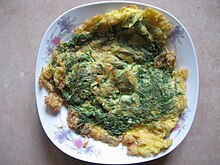Senegalia pennata
| Senegalia pennata | |
|---|---|

| |
| Scientific classification | |
| Kingdom: | |
| (unranked): | |
| (unranked): | |
| (unranked): | |
| Order: | |
| Family: | |
| Genus: | |
| Species: | S. pennata
|
| Binomial name | |
| Senegalia pennata (L.) Maslin
| |
| Synonyms | |
| |


Senegalia pennata (English: Climbing wattle, Thai: ชะอม Cha-om, Burmese Su pout ywet, Khmer: ស្អំ), Thadou-Kuki Khang-khu or Khangkhuh, Mizo (Khanghu), Hmar (Khanghmuk), Biate (Khang-Hu)), is a species of legume which is native to South and Southeast Asia. It is a shrub or small tropical tree which grows up to 5 metres in height. Its leaves are bipinnate with linear-oblong and glabrous pinnules. Its yellowish flowers are terminal panicles with globose heads. The pods are thin, flat and long with thick sutures.[1]
Uses
In India, the Northeast State Mizoram Manipur use climbing wattle as ingredient for indigenous cuisine like Kaang-hou (Fried Vegetables), Eromba and much more. Its locally known as Khangkhuh.
In Burma, Cambodia, Laos, Indonesia and Thailand, the feathery shoots of Senegalia pennata are used in soups, curries, omelettes and stir-fries.[2] The edible shoots are picked up before they become tough and thorny.[3]
In Northern Thai cuisine Cha-om is also eaten raw with Thai salads, such as Tam Mamuang (mango salad),[4] and it is one of the ingredients of the Kaeng khae curry.[5] In Central Thailand and Isan it is usually boiled or fried. Cha-om omelet pieces are one of the usual ingredients of Nam phrik pla thu and commonly used in Kaeng som, a sour Thai curry.
See also
- List of plants with edible leaves
- Thai cuisine
- Lao cuisine
- Flora of Madhya Pradesh
- List of ingredients in Burmese cuisine
- List of Thai ingredients
